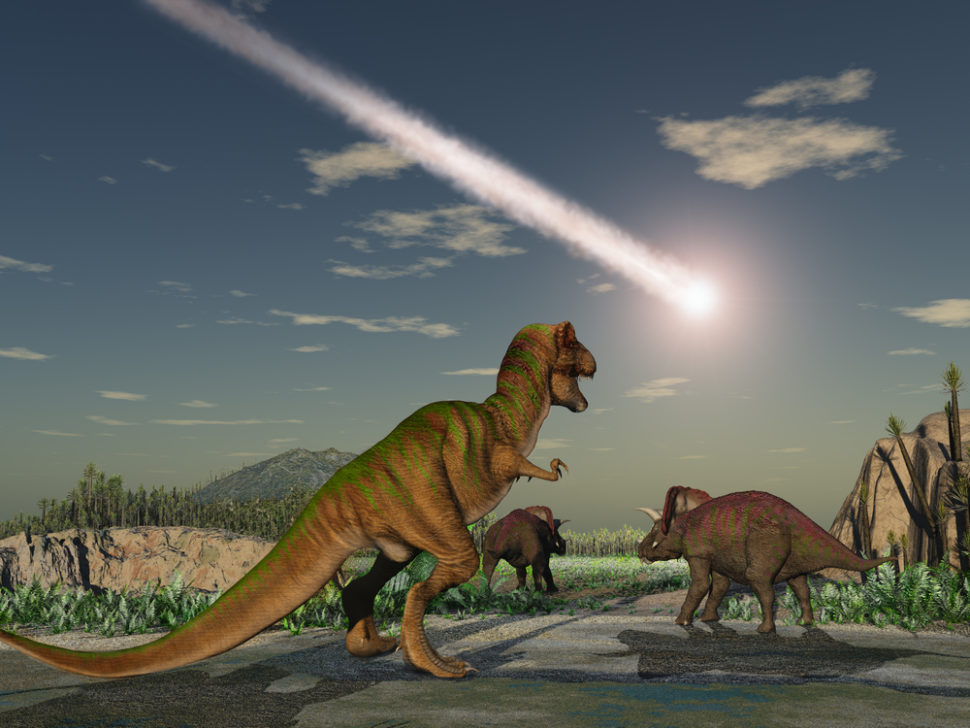Sixty-six million years ago, dinosaurs and all lifeforms living on Earth had a terrible day that would go down in the annals of history as one of the deadliest days ever.
On that fateful day, a giant asteroid, measuring between 10.6 km to 80.9 km across, slammed into the ocean offshore of the Yucatán Peninsula, near Chicxulub in Mexico.
The Chicxulub impact triggered a major extinction wave, known as the Cretaceous mass extinction event, that wiped out over three quarters (75%) of all land and sea species.
Famous for potentially being the cause of the dinosaurs’ extinction, scientists still know less about what happened on the last day of dinosaurs.
But now, we have a better idea of how dinos met their demise.
Painting a More Detailed Picture of the Last Day of Dinosaurs
Paleontologists know more about the remote consequences of the asteroid strike, documented in the fossil records, than the few hours following the impact.
However, an international team of more than two dozen scientists, led by researchers from the University of Texas at Austin (UT), has found “hard evidence in the hundreds of feet of rocks that filled the impact crater within the first 24 hours after impact.”
Geologists had to drill into the rock, 500 to 1,300 meters (1,640 to 4,265 feet) below the Chicxulub crater’s ground zero, to find core samples of charcoal, melted rock, and the curious absence of sulfur in the cores.
The work started in 2016 with the International Ocean Discovery Program scientific drilling mission that aimed to extract the rocks from the Chicxulub impact site.
Here’s an interactive video explaining the mission. Use your mouse or finger to navigate this 360° VR video.
Sean Gulick, a research professor at the University of Texas Institute for Geophysics, led the present study and co-led the International Ocean Discovery Program.
“It’s an expanded record of events that we were able to recover from within ground zero,” said Gulick. “It tells us about impact processes from an eyewitness location.”
The impact, after the mighty and blinding fireball appeared in the sky, triggered a chain of massive tsunamis and wildfires. So much sulfur was released into the atmosphere that it eclipsed the sun.
A global cooling ensued and that ultimately doomed the dinos.
First Day of Mammals!
Here’s how the last day of dinosaurs unfolded in details, as described in the paper published this week in the Proceedings of the National Academy of Sciences:
“Within minutes of the impact, centrally uplifted basement rock collapsed outward to form a peak ring capped in melt rock. Within tens of minutes, the peak ring was covered in ∼40 m of brecciated impact melt rock and coarse-grained suevite… Within an hour, resurge crested the peak ring, depositing a 10-m-thick layer of suevite with increased particle roundness and sorting. Within hours, the full resurge deposit formed through settling and seiches, resulting in an 80-m-thick fining-upward, sorted suevite in the flooded crater. Within a day, the reflected rim-wave tsunami reached the crater, depositing a cross-bedded sand-to-fine gravel layer…”
This work also builds on previous research efforts co-led by the UT’s Jackson School of Geosciences, describing the crater’s formation and how life recovered rapidly at the impact site.
If it’s of any consolation, the last day of the dinosaurs may have been a bit shorter than today’s 24h-day, a few hours shorter.
That’s because, in addition to the moon’s action, Earth was still tuning in its spinning velocity during the dinosaur age in the Mesozoic era, from 250 to 65 million years ago. The last day of the dinosaurs was probably between 21 and 23 hours. Not all dinosaurs perished that day, although they all died within a few months after the strike. The last dinos’ world was dark and cold, with food getting more and more scarce.
All that said, maybe humans couldn’t even have had the chance to arise if it wasn’t for this asteroid impact. After dinos were out of the picture, it was the time for mammals and flowering plants to reign over Earth.
But now, mammals themselves are starting to go extinct, and scientists fear that we’re heading toward another mass extinction event due to human-driven climate change.



















Comments (0)
Most Recent